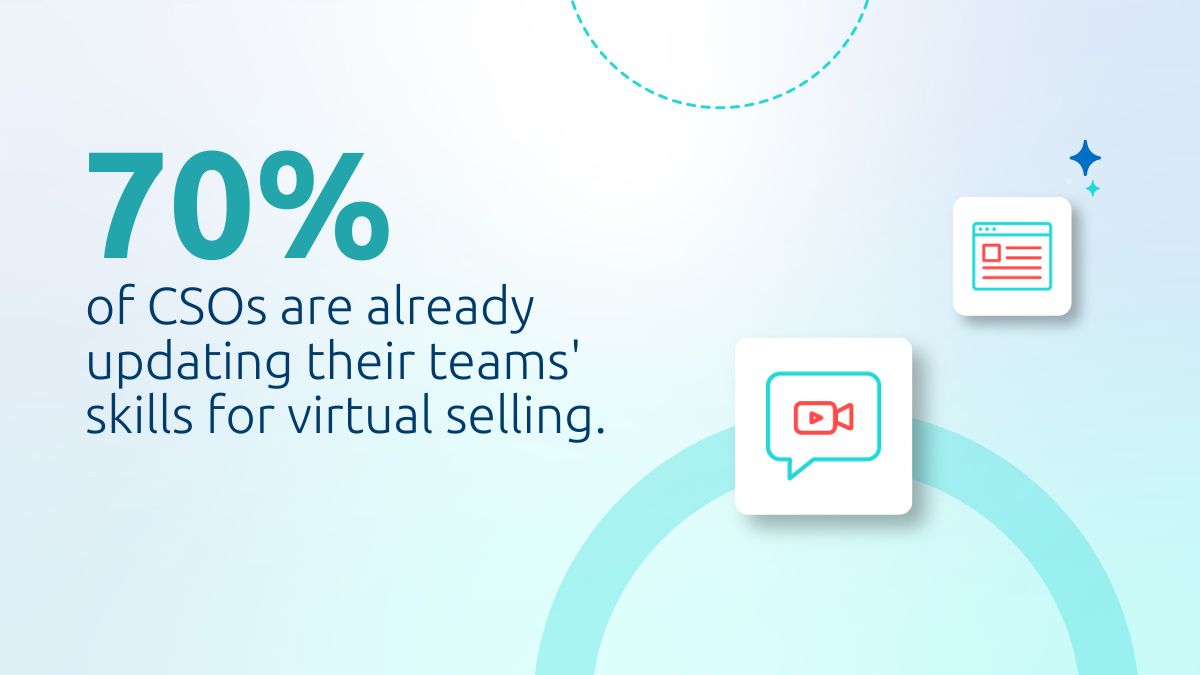Around 80% of buyers and sellers favor digital self-serve and remote human engagement over face-to-face interactions for a seamless buying experience. This trend has gained momentum thanks to the growing influence of online platforms. In turn, businesses have to adapt and innovate in virtual selling.
Discover how mastering virtual sales strategies can elevate customer interactions, even in complex sales cycles.
- What Is Virtual Selling?
- What Does Virtual Selling Look Like?
- Ways Virtual Selling Can Benefit Your Business
- Virtual Selling Best Practices and Tips
- Virtual Selling Tools
- Virtual Selling Challenges
What Is Virtual Selling?
Virtual selling is a technology-driven approach to sales. Unlike traditional face-to-face interactions, sales reps use digital tools to engage with customers remotely. This method allows them to connect with global clients without travel, fostering a convenient customer experience.
Initially viewed as a cost-effective selling strategy primarily for lower-value accounts, virtual selling has now gained favor for a broader range of opportunities. Many customers have preferred digital channels, prompting companies to incorporate them into their sales practices. This shift isn’t limited to simple transactions; even complex buying cycles are navigated virtually, requiring careful planning.
Why Virtual Sales Skills Training Matters
The shift from in-person to remote work demands new skills. With only 33% of salespeople effective in virtual environments, training in virtual sales skills, emphasizing digital communication and platform proficiency, is crucial to adapting to customer needs in a virtual setting.
Since the COVID-19 pandemic, many companies have started to recognize the value of leveraging data-driven sales training platforms to help sales reps quickly adapt and excel. These platforms offer a centralized and accessible hub for hands-on practice, role play simulations, and on-demand learning resources to ensure sales teams stay ahead of the curve and meet the demands of the ever-changing market.
Skills You Need to Excel at Virtual Selling
To excel in virtual selling, a blend of traditional sales skills and digital fluency is vital. Essential skills include the ability to:
- Master digital technology: Learn and utilize digital tools and platforms to enhance sales effectiveness.
- Enhance communication skills: Focus on delivering clear, concise messages adapting to digital mediums to overcome communication barriers.
- Embrace adaptability: Continuously evolve sales strategies to stay competitive.
- Engage customers effectively: Use digital channels to create compelling, personal human connections with customers.
- Practice empathy and listening: Listen attentively and empathetically to understand and address customer needs and challenges.
- Optimize time management: Efficiently allocate time and resources to maximize productivity in a virtual selling environment.
- Foster self-motivation: Cultivate a proactive mindset to stay motivated and driven in a remote selling setting.
Despite the gradual shift back to in-person work, the conveniences that come with virtual selling are irreplaceable, necessitating sales rep adaptability to diverse working environments.
What Does Virtual Selling Look Like?
Virtual selling extends beyond email and video meetings. Leveraging various digital platforms will help enhance customer engagement throughout the sales process. Here’s a closer look at what virtual selling entails in day-to-day sales:
1. Prospecting
Virtual prospecting utilizes tools like email, social media, and video to reach potential customers. Sales reps can curate content like webinars and case studies to showcase expertise.
2. Pre-call Planning
Successful virtual sales calls require careful planning and communication. Establish clear expectations and processes before the first call. Provide instructions for joining calls and offer alternative connection methods to avoid technical glitches.
3. Sales Meetings and Follow-ups
Virtual calls, often via platforms like Zoom, digitize in-person meetings. Video aids in understanding body language and forging personal connections. Using video for follow-up summaries offers consistent messaging to multiple decision-makers. Analytics gauges message success through viewer engagement.
4. Introductions and Handoffs
In the virtual sales process, trust can fall apart during handoffs. Introduction videos can help build trust and familiarity. Whether it’s a BDR’s initial call setup or introducing new team members, smooth transitions can preserve relationships.
Ways Virtual Selling Can Benefit Your Business
Virtual selling is a response to our global market and evolving buying practices. It transcends physical boundaries, boosts productivity, and offers flexibility. This way of selling provides benefits that traditional selling can’t match.
Reach People Globally
Imagine connecting with customers across different continents as easily as you would with someone in your city. Virtual selling breaks down the distance barriers, making the entire world your marketplace without extensive travel.
Increase Productivity
Think about all the hours field salespeople spend on the road or in the air. Virtual selling shifts this time back to where it counts: engaging with customers and closing deals. It’s about doing more selling and less traveling.
Adaptability to Changing Situations
If recent times have taught us anything, it’s the value of adaptability. Virtual selling is resilient, enabling your business to keep working even when the market gets choppy.
Ease of Scheduling
It is no longer necessary to juggle time zones and travel schedules for a meeting. Virtual selling brings in the ease of scheduling meetings at times that suit everyone, even if it’s early mornings or late evenings.
Comfort
There’s a comfort factor with virtual selling for both you and your customers. Engaging in discussions in environments where everyone feels at ease can lead to more open, genuine, and productive sales conversations.
Support Customer Preferences and Flexibility
Customers value convenience and flexibility, and virtual selling hits the mark. It’s a strategy that aligns with the modern customer’s lifestyle. It’s convenient, flexible, and if executed well, highly personalized.
The Ability to Show vs Tell
In virtual selling, you don’t just talk about your product or service; you bring it to life on screen. This dynamic way of showcasing your offer can help customers better understand and appreciate your solutions.
Virtual Selling Best Practices and Tips
To excel in virtual sales, it’s essential for your sales team and the entire business to be adaptable. Your sales process will require new technology and techniques at every stage. Lean into strategy development, customer needs, communication, and ongoing training.
1. Engage Your Sales Team
Acknowledge that shifting primarily to virtual selling may not be universally embraced, as evidenced by only 25% of field reps expressing enthusiasm for such a change. To foster buy-in, actively involve your sales professionals in developing the strategy, ensure the integration of user-friendly tools for both customers and reps, and plan the transition carefully to reduce any potential friction.
2. Arm Yourself with Customer Insight
Before any meeting, ensure you’re well informed about who you’re meeting with. This means understanding their company, identifying their pain points, and preparing solutions tailored to their needs.
3. Clarify the Virtual Selling Process
There may be apprehensions about information security and contract signing for customers new to online sales interactions. It’s important to thoroughly explain the process and reassure them about the security measures.
4. Diversify Communication and Use Visuals
Adapt to each client’s preferred communication style, whether it’s through phone calls, text messages, or emails. Enhance your communication and presentations with high-quality visuals to make a more substantial impact and keep your client engaged.
5. Redesign Your Sales Process
Adapting to virtual selling involves rethinking your entire sales approach to engage with customers in a digital environment.
- Synchronous Engagement – Synchronous engagement revolves around real-time interactions. This digital version of face-to-face meetings can include video calls, messaging, or phone calls. It’s about replicating personal connections where ideas are exchanged and decisions are made.
- Asynchronous Engagement – Asynchronous engagement breaks free from the constraints of real-time communication. It emphasizes flexibility and respect for the client’s time, allowing them to engage with your content conveniently. It encompasses email, recorded video messages, and Digital Sales Rooms (DSRs).
- Virtual Sales Enablement – Virtual sales enablement arms your sales team with the necessary tools and resources for virtual selling success. It includes training, accessible content, and support systems designed for virtual engagement. CRM systems, collaboration tools, and targeted training programs are essential.
6. Make the Most of Content
A RAIN Group report indicates that only 16% of B2B buyers find virtual sales reps effective in explaining ROI. This highlights the need for sales and marketing collaboration in creating personalized content. Marketers must understand the sales process, and sellers must know how to use this content to enhance revenue.
Download Resource: The All-In-One Sales Content Management Toolkit
7. Prioritize Virtual Selling in Training and Enablement
It’s essential for sales leaders to not only prioritize sales training sessions but to coach reps as they refine their virtual selling skills. Keeping the training interactive and exciting keeps your sales team on their toes and constantly improving.

Source: Gartner
The move towards virtual sales is what the buyers want. Gartner points out that sales enablement leaders are zeroing in on virtual sales training, sales coaching, and other resources. In fact, 74% of CSOs are already updating their teams’ skills for virtual selling, and 61% are allocating more money into new tech for this. It’s clear that virtual selling isn’t just a phase – it’s the new norm.
Virtual Selling Tools
Falling behind in adopting the latest tools for virtual sales can put you at a significant disadvantage. Competitors using these modern platforms may outpace you, potentially capturing your market share.
Below are six tools designed to support your sales organization:
- Collaboration tools (like Google Docs): Google Docs allows teams to collaborate in real time, working together on documents, spreadsheets, and presentations from anywhere.
- CRM tools: These tools manage customer relationships and sales processes, offering a centralized platform for tracking interactions, sales opportunities, and customer data.
- Sales enablement tools (like Highspot): Highspot provides a platform for sales teams to access relevant content, training resources, and analytics, enhancing customer engagement.
- Video conferencing tools (like Zoom): Zoom facilitates virtual face-to-face meetings, ideal for sales presentations, team meetings, and client consultations.
- Social media tools (like LinkedIn): LinkedIn is a crucial tool for social selling, networking, prospecting, and building professional connections, essential for sales opportunities and relationship building.
- Secure e-signature tools: These tools enable secure digital signing of contracts and agreements, streamlining the sales process and reducing turnaround times.
Virtual Selling Challenges
Virtual selling, while necessary for today’s buyers, presents unique challenges. Here’s a look at some common hurdles and strategies for overcoming them:
- Building rapport: Developing trust and connection in a virtual setting can be challenging due to the absence of physical cues and facial expressions. However, building a trusting relationship is achievable through consistent communication and virtual meetings.
- Technical issues: Dealing with connectivity problems requires planning and clear communication. If technology fails, always have a backup plan, like a direct call option.
- Customer engagement: Using relevant content to keep clients digitally engaged is crucial. Linking content with CRM data can provide tailored content recommendations. Fiserv utilizes Highspot to suggest content like talking points, templates, sales scripts, and pitches tailored to a buyer’s profile and stage.
- Adapting sales techniques: It’s not enough to add a digital tool like Zoom; every stage of the sales process must be optimized for virtual selling. This includes revising traditional sales strategies to fit the virtual format, ensuring a seamless sales experience across channels.
Successfully navigating these challenges will help your sales team thrive in virtual selling, ensuring quality customer connections and business growth.
Optimize Your Virtual Sales Strategy with Highspot
The key to success in virtual selling lies in finding the perfect mix of virtual, phone, and field sales. This balance allows for remote interactions alongside in-person engagement when a more direct approach is necessary. Leading companies in virtual selling have evolved beyond just tweaking their traditional sales models. They have instead mastered the art of virtual sales across all types of deals and accounts, crafting strategies that truly resonate with today’s digital-first customer.
Whether in-person, hybrid, or virtual selling, now is the time to reimagine your virtual sales training and tools with Highspot. Request a demo today.


